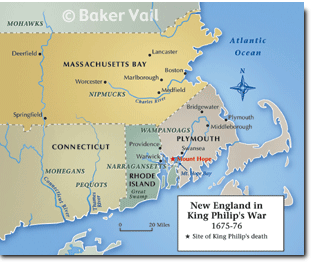Claire Netemeyer APUSH website 2015-16
King Phillip's War
Location: Northern New England (Western Massachusetts, Rhode Island, Connecticut) (Brinkley, 40)
Date: Spring 1675 (death of Sassamon) through August 1676 (death of King Phillip (Brinkley, 40)
Leaders:
Indians: King Phillip (Metacomet)
Colonists: Benjamin Church, Major John Talcott (HistoryBits)
Main consequences: Ravaging effects on both population and and that took many years to recover from; severe devastaion to Indian tribes. (HistoryBits)

The English coexisted fairly peacefully with the native American Indians in north new England, but tensions as English population expanded and possessed more land and food sources became more scarce, sporadic skirmishes and hostilities increased between the English and the Indians (Pletcher, 4-6). In the spring of 1675, John Sassamon (Metacomet’s advisor), a local Indian who had converted to Christianity, was killed (Totally History). The English suspected that the chief of the Wampanoag Indian tribe (Metacomet, also known to the English as “King Phillip”) had ordered him to be killed in order to silence him, since he was thought to be an informer for the English (HistoryBits). The English authorities seized 3 Wampanoag Indians and tried them for the murder of Sassamon and executed them (HistoryBits). 2 weeks later, the Wampanoag Indians returned and raided and burned the village of Swansea, officially beginning the war (HistoryBits).

Early in the war, the English were at a disadvantage because their traditional war tactic (marching closely together and shooting together towards the enemy) was poorly suited for the wooded, hilly terrain of New England (where as the tactic worked in Old England) (HistoryBits). Indians hit behind trees and boulders, leaving English militiamen often as the victims of sniper fire. The Colonists began adapting their style of warfare and they were also helped by many Indian tribes, including the Mohegan, Massachusetts, Pequot, and Nausset tribes (HistoryBits). In particular, Benjamin Church was one of the greatest Indian fighters who is credited with teaching the English forces to copy the Indians’ battle tactics (HistoryBits). Church is now known as the Father of American Army Rangers, which are elite, special military forces (HistoryBits).

By the middle of 1676, English forces had begun to win many battles and the colony of Massachusetts offered amnesty to Indians who surrendered – and many of them did (HistoryBits). Large Numbers of Indians were captured and sold as slaves in the Caribbean islands (HistoryBits). Church and his forces captured King Phillip’s wife and son and sold them into slavery in the West Indies (HistoryBits). An informer then supplied Church with Phillip’s location in Rhode Island and he was killed. His body was quartered; his hand preserved in a bucket of rum to be used as a war trophy, and his head was taken to Plymouth and displayed on a pole for over 20 years (HistoryBits). The war was over and the Wampanoag tribe was all but eliminated – killed or sold into slavery/servitude (HistoryBits).
Overall, King Phillip’s war was the most destructive war in American history, in terms of percentage of casualties compared to the population at the time and the complete devastation of towns and villages in northern New England (HistoryBits). More than half of New England’s towns were attacked and thousands of homes were destroyed (HistoryBits). Approximately 800 of 52,000 colonists died and approximately 3,000 of 20,000 Native Americans died (Totally History). The war is known for the savagery of its fighting practices and gruesome loss of life and property on both sides.

Bibliography
"King Phillip's War." HistoryBits. ThorFire Enterprises, n.d. Web. 7 Oct. 2015.
"What Was King Philip’s War? (1675-1676)." Totally History King Philips War 16751676 Comments. Totally History, n.d. Web. 07 Oct. 2015.
Pletcher, Larry. It Happened in Massachusetts. Kearny, NE: Morris Book, 2009. Print.
Brinkley, Alan. The Unfinished Nation. 6th ed. New York, NY: McGraw-Hill, 2010. Print.